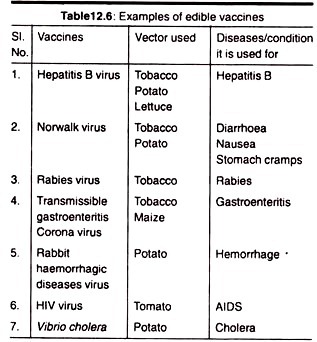In this article we will discuss about Edible Vaccines:- 1. Method of Developing an Edible Vaccine 2. Candidates for Edible Vaccines 3. Applications 4. Advantages 5. Limitations.
Contents:
- Method of Developing an Edible Vaccine
- Candidates for Edible Vaccines
- Applications of Edible Vaccines
- Advantages of Edible Vaccines
- Limitations of Edible Vaccines
1. Method of Developing an Edible Vaccine:
Gene encoding antigen from pathogenic organisms (virus, bacteria or parasites) that have been characterized and for which antibodies are available, can be produced in the edible parts of the plants in two ways. In one case, the entire structural gene is inserted into a plant transformation vector.
This will allow transcription and accumulation of coding sequence in plant. In second case, epitope within the antigen are identified, DNA fragment encoding these can be used to construct genes by fusion with a coat protein gene from plant virus, e.g., TMV or CMV. The recombinant virus is then used to infect stabilized plants. The resultant edible plant vaccines are utilized for further immunological studies.
2. Candidates for Edible Vaccines:
Foods under study of edible vaccines include bananas, potatoes and tomatoes as well as lettuce, rice, wheat, soybean and corn. When choosing a plant to be used as a vaccine it is important that it is a hardy, palatable plant with high nutritive and protein content. The plant is also one that would best be indigenous to the country in which it is to be used and should be able to be transformed with relative ease.
3. Applications of Edible Vaccines:
(a) Malaria:
Malaria remains one of the most significant causes of human morbidity and mortality worldwide, with 300 to 500 million new cases of infection annually resulting in 1.5 to 2.7 million deaths. Three antigens are currently being investigated for the development of a plant-based malaria vaccine, merozoite surface protein (MSP) 4 and MSP 5 from Plasmodium falciparum, and MSP 4/5 from P. yoelli.
(b) Hepatitis B:
The hepatitis B virus is estimated to have infected 400 million people throughout the globe, making it one of the most common human pathogens. The hepatitis B surface antigen (HbsAg) is used as a vaccine against Hepatitis B.
The HbsAg subtype ayw was cloned into CaMv plasmid and the regenerated plants from the transformed cells were shown to produce HbsAg. Furthermore, expression of the antigen was found to be higher in roots of the transgenic potato than in leaf tissues.
(c) Measles:
Measles is a highly contagious viral disease caused by the Paramyxo virus spread by air and includes symptoms such as high fever, skin rash and spots. Each year, almost one million children die from the measles and many of the survivors are weakened by pneumonia or encephalitis or become deaf.
Recent studies report expression of the Paramyxo virus surface protein haemagglutinin in tobacco, potato, rice and lettuce with satisfying results.
(d) Stopping Autoimmunity:
In the past 15 years, investigators have identified several cell proteins that can elicit autoimmunity in people predisposed to Type I diabetes. The development of plant based diabetes vaccine in potato was attempted.
The development of transgenic potato and tobacco plants when fed to non-obese diabetic mice showed increased levels of IgG, an antibody associated with cytokines that suppress harmful immune response. Feeding of the vaccines to mouse strain that becomes diabetic helped to suppress the autoimmune attack and to prevent the delay of high blood sugar.
4. Advantages of Edible Vaccines:
Potential advantages of plant-based vaccines are:
a. Edible means of administration.
b. Reduced need for medical personnel and sterile injection conditions.
c. Economical in mass production and transportation.
d. Therapeutic proteins are free of pathogens and toxins.
e. Storage near the site of use.
f. Heat stable, eliminating the need for refrigeration.
g. Antigen protection through bio-encapsulation.
h. Subunit vaccine (not attenuated pathogens) means improved safety.
i. Seroconversion in the presence of maternal antibodies.
j. Generation of systemic and mucosal immunity.
k. Enhanced compliance (especially in children).
l. Delivery of multiple antigens.
m. Integration with other vaccine approaches.
n. Plant derived antigens assemble spontaneously into oligomers and into virus like particles.
5. Limitations of Edible Vaccines:
a. Development of immuno tolerance to vaccine peptide or protein.
b. Consistency of dosage form fruit to fruit, plant to plant, and generation-to-generation is not similar.
c. Stability of vaccine in fruit is not known.
d. Evaluating dosage requirement is tedious.
e. Selection of best plant is difficult.
f. Certain foods like potato are not eaten raw, and cooking the food might weaken the medicine present in it.

